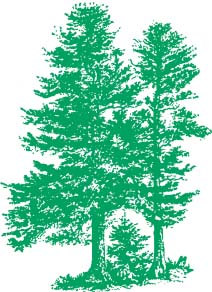 |
|
 |
|
|
Teresa Wood and I were visiting in the San Francisco Bay Area when we heard on the noontime news of the attack on Luna (see Luna - Illegally Cut and Endangered by Dana Stolzman). Having visited Julia Butterfly Hill in Luna twice during her tree-sit, we were devastated by the report. A few days later we found ourselves in Redway, up in Humboldt County. Unaware of the nationwide effort already underway to come up with a plan to stabilize and protect Luna, we walked into the Circle of Life Foundation's office to offer our help. Due to our work in South America constructing canopy walkways in the rainforest, we had a lot of experience supporting large trees with steel guying cables. It seemed to us that this would be a good, non-invasive solution to help keep Luna upright in the face of the strong winter winds she would soon be experiencing. Dana Stolzman, the foundation's director, listened to our idea, then explained the efforts already underway by the team of arborists, engineers, foresters, and biologists that had been assembled. While she began contacting the key people involved in the effort, Teresa and I, along with FEN director Jonathan Carter (coincidentally also in the area) and local activist Sawyer headed up to Stafford for a first hand look at the damage done to Luna. 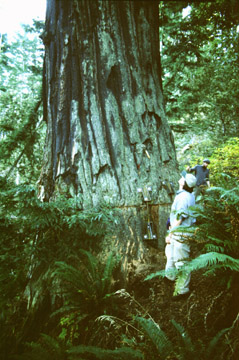
Despite having seen all the pictures on the news, the first sight of the deep cut in Luna's trunk sickened us. We were last at Luna a year and a half earlier, and at that point she was a healthy, thriving tree. Now her massive trunk had been cut more than two-thirds of the way through. On top of that, her trunk was visually marred by six large braces that had been hastily put in place to stabilize the tree for the short term. After getting over the shock of seeing the damage, we examined Luna for her cabling possibilities and it looked like our idea would work. It took Dana 24 hours to contact all the key players in Luna's medical team (Dennis Yniguez, the President of the American Society of Consulting Arborists and the coordinator of the Luna medical team was at a conference in Rhode Island), but eventually we were given a green light by Julia and the team to carry out our plan. The next day we were headed back up to Luna to start the cabling work, riding in the back of an orange Pacific Lumber (PL) pickup truck with one of their "compliance foresters" at the wheel. Despite having been frustrasted in their logging efforts for more than two years by Julia's tree-sit, the company was cooperating in the protection effort for the tree, eager to see the story disappear from the news as soon as possible. It was a surreal experience, to say the least. When we'd last visited Julia a year and a half ago, we kept off PL's gravel logging roads and took trails through the woods to avoid PL personnel. Riding in the pickup with us today were Sawyer and Duff, two local forest activists and tree-climbers with the Mattole Forest Defenders who only a couple of days earlier had been battling PL and Humboldt County Sherriff's deputies on Rainbow Ridge, just a scant seven miles to the southwest of Luna. The gravel road up to Luna took us through PL clearcuts of all conditions - impossibly steep, naked, eroded hillsides where not a single plant had grown since our last visit in June 1999, clearcuts with scrubby orange vegetation killed by herbicide spray, and other clearcuts still black and smoking from the Napalm dropped to burn off the slash. From high on the ridge above Luna we had a clear view of the blight of PL's patchwork clearcuts covering the landscape. Most bizarre of all, the whole time we were working to save a single tree we could hear the roar of a large twin-bladed Chinook helicopter coursing over the steep slopes across the Eel River from us, hauling out huge tree trunks in a PL helicopter logging operation. That first day, due to a shortage of both time and needed climbing gear, we accomplished very little. We returned much better equipped the next morning, accompanied by redwood canopy biologist Dr. Steve Sillett of Humboldt State University, Jim Spickler, a graduate student and fellow redwood researcher at HSU, civil engineer Steve Salzman, videomaker Thomas Dunklin (to document the work), and Sanctuary Forest director Eric Goldsmith. 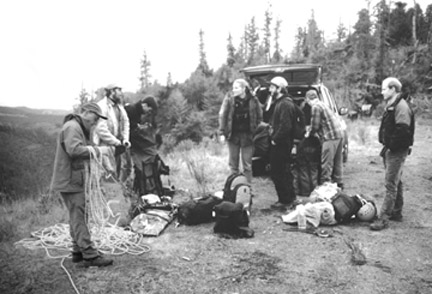 Due to Steve and Jim's extensive experience in rigging large Coast Redwoods, we were able to get up into Luna fairly quickly. Once we had lugged the mountain of gear down to the base of Luna, Jim used a 70-lb. pull bow to shoot an arrow and light line high into Luna's crown. It took several shots, but within 20 minutes or so we had a line into the crown. With that light line, a heavier line was pulled up, then the heavier line was used to pull up a climbing rope. Once the the climbing rope was anchored, Jim, Steve Sillett, and I put on harnesses and climbed up into Luna. 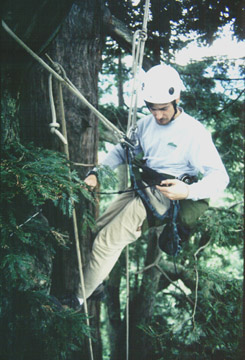
We were up in Luna until later afternoon, securing a huge collar of steel cable around her trunk about 110 feet above the ground. The collar serves as the attachment point for three steel cable guy lines that run back to the hillside behind the tree. While we were at work up in Luna, Steve Salzman crawled around on the steep hillside above her to locate suitable anchor points for the steel guying cables. Our last task of the day was to use a crossbow to shoot light lines down to the ground anchors that Steve had located. These lines would eventually be used to pull the guying cables up into Luna. 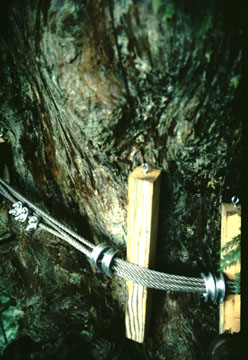 About ten days later, after Teresa and I had returned to Maine, Steve, Jim and Steve went back up to Luna to complete the job, attaching the three steel guy cables. Luna seems to have made it through this winter, and it's hoped by all that the cables will help keep Luna standing for many years to come as a beacon to forest activists around the world. |
283 Water Street, 3rd floor, P.O. Box 2118, Augusta, Maine 04338 phone: 207-628-6404 fax - 207-628-5741 email: fen@powerlink.net